Running a field service company is tough.
Every job, truck, and invoice must move quickly and smoothly.
If things slow down, profits shrink.
The right software can change that. It can save time, reduce costs, and enable crews to work more efficiently.
In this guide, we examined the top field service apps for 2025. Each one is the best in its class.
We categorized them into areas such as route planning, contractor management, team scheduling, mobile apps, equipment maintenance, and invoicing.
We judged them on:
- What users say in reviews (G2, Capterra, Gartner)
- Features and ease of use
- How well they work on mobile
- Clear and fair pricing
- Fit for small businesses or big enterprises
- How much do they help save money and boost efficiency
TL;DR
Here are the winners if you just want the quick answer, plus why they stand out:
- Best Route Optimization: Elogii – powerful routing that cuts operating costs and makes deliveries run smoother. Book a demo today.
- Best Contractor Management: Simpro – Covers the entire job cycle from quotes to invoices, making it great for trade contractors.
- Best Workforce Software: Salesforce Field Service – strong scheduling and dispatch tools tied into the Salesforce CRM.
- Best Mobile-First All-in-One App: Connecteam – easy to use on mobile, great for scheduling, checklists, and team communication.
- Best Equipment & Asset Maintenance: UpKeep – a mobile-first CMMS that simplifies asset tracking and prevents breakdowns.
- Best Quoting & Invoicing: FreshBooks – user-friendly invoicing and billing that saves time for small service businesses.
Best Route Optimization Software
When routes are messy, profits suffer. That’s why we compared four top routing tools: Elogii, OptimoRoute, WorkWave Service, and Oracle Field Service app.
We examined the intelligence of their routing engines, their ability to manage large fleets, and the potential savings they can offer.
How Elogii Compares
We looked at Elogii, OptimoRoute, WorkWave Service, and Oracle Field Service.
OptimoRoute is suitable for small to mid-sized delivery teams, but it lacks some automation features.
WorkWave Service works well for service businesses but can feel limited for logistics-heavy fleets.
Oracle Field Service is powerful for enterprises, but it is complex and costly to set up.
Elogii came out on top because it balances strong routing power with ease of use, fair pricing, and scalability.
|
Software
|
Best For
|
Strengths
|
Weaknesses
|
|
Elogii
|
Medium to large fleets
|
Real-time ETAs, scalable, cost savings
|
Maps could look better
|
|
OptimoRoute
|
Small to mid-size teams
|
Easy to set up, affordable
|
Fewer automation features
|
|
WorkWave Service
|
Service-based businesses
|
Good for scheduling + invoicing
|
Limited logistics capabilities
|
|
Oracle Field Service
|
Large enterprises
|
Very powerful, predictive analytics
|
Complex, expensive to implement
|
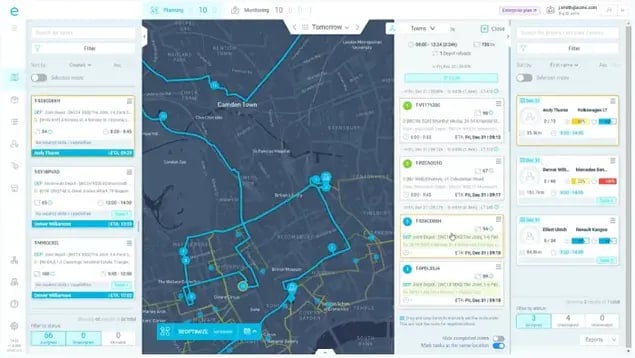
Main Benefits of Elogii
- Better customer experience - Accurate ETAs and live updates mean fewer missed appointments and happier customers. This leads to more repeat business and stronger service-level agreements (SLAs).
- Lower operating costs - Smarter routing lowers fuel use and labor hours. That means more jobs completed per shift and higher profit margins.
- Scales as you grow - Unlimited users and vehicles let companies add new crews and trucks without extra cost penalties. This helps businesses expand without worrying about software limits.
- Saves dispatcher time - Automated planning removes hours of manual work each day. Dispatchers can focus on solving customer issues instead of moving pins on a map.
Elogii Pros
- Real-time route planning and updates with accurate ETAs. This means dispatchers and customers always know when a driver will arrive, which reduces wasted time and customer complaints.
- Handles multiple depots, vehicles, and an unlimited number of drivers. This flexibility makes it a good choice for growing companies that don’t want to be restricted by user limits.
- Cuts costs by up to 50% for many businesses. With fewer miles driven and less time wasted, fuel costs, labor hours, and overtime expenses decrease.
- Great support team and flexible API integrations. We have fast responses from support, and it is easy to connect Elogii with their existing systems.
Elogii Cons
- Map visuals could be more polished. While the routing engine is strong, some users mention the maps look dated and could be easier to read at a glance.
- Works best for companies with 80 or more daily tasks. Smaller teams may find the system more powerful than they need and may not fully realize its value.
Elogii Pricing
- Pricing is custom for each business, based on the number of tasks and operational needs. Elogii does not limit users, drivers, or vehicles, so costs scale with task volume rather than headcount.
- Companies handling higher volumes can request tailored pricing plans. These are built to handle large operations and enterprise requirements.
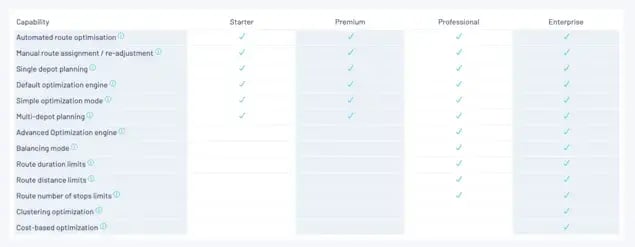
Best Contractor Management Software
Contractors need tools that keep jobs moving from start to finish. We looked at Simpro, Housecall Pro, Jobber, and FieldAware. We focused on how they handle quoting, scheduling, billing, and project management.
How Simpro Compares
Simpro is a field service app designed for trade contractors who need to manage every part of the job cycle.
Housecall Pro is simple and good for small residential teams, but it lacks depth for complex projects.
Jobber is user-friendly, but it primarily focuses on scheduling and invoicing rather than project management.
FieldAware offers good usability, but it is not as comprehensive for contractors who require both field and back-office tools.
Simpro stands out because it ties everything together—jobs, quotes, invoices, and inventory—in one system.
|
Software
|
Best For
|
Strengths
|
Weaknesses
|
|
Simpro
|
Trade contractors
|
Full job cycle, project + billing tools
|
No GPS tracking
|
|
Housecall Pro
|
Small residential teams
|
Simple setup, good scheduling and invoicing
|
Limited advanced features
|
|
Jobber
|
SMB field service
|
Easy to use, solid invoicing + scheduling
|
Lacks complex project tools
|
|
FieldAware
|
Mid-size businesses
|
User-friendly, good workflows
|
Not as deep as Simpro
|
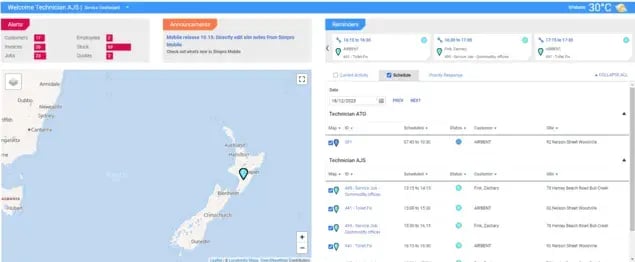
Main Benefits of Simpro
- End-to-end job management - From quotes to invoices, contractors save time by keeping everything in one place.
- Better cost control - Built-in inventory and reporting tools help reduce waste and improve profit margins.
- More organized teams - Schedules, tasks, and billing are connected, which means fewer mistakes and missed jobs.
- Grows with your business - Flexible modules and integrations make it easy to expand as your company takes on more work.
Simpro Pros
- Covers the entire job lifecycle with quoting, scheduling, invoicing, and reporting. This means contractors can manage every stage of work without jumping between different tools, which reduces errors and saves time.
- Over 100 integrations to connect with other business tools. For example, it links with accounting software, CRMs, and payment platforms so data flows across the business.
- Strong customization options allow businesses to adapt it to their specific needs. From setting up workflows to customizing fields, companies can tailor Simpro to match their unique operating style.
- Saves admin time by reducing double entry and paperwork. Teams can input information once and use it everywhere, which speeds up back-office work.
Simpro Cons
- No built-in GPS or location tracking for crews. Contractors may need a separate solution for real-time location data.
- Time tracking can be less accurate when timers overlap. This can cause small errors in labor reporting.
- Some users mention it takes training to learn the full system. With so many features, there is a learning curve for new users.
Simpro Pricing
- Pricing is custom and based on modules and company size. Contractors need to request a quote to get exact costs.
- Companies can start small and add modules as they grow. This flexibility helps spread out costs and avoid paying for tools before they’re needed.
Best Mobile Workforce Software
Coordinating teams in the field is one of the most challenging aspects of the job. We compared Salesforce Field Service app, Connecteam, Field Nation, and Jobber.
We examined scheduling, dispatching, mobile use, and how well the software integrates with the rest of the business.
How Salesforce Field Service Compares
Salesforce Field Service is a field service app that’s part of the Salesforce ecosystem, giving it an edge for companies already using Salesforce CRM.
Connecteam is great for smaller teams, but doesn’t have the depth that larger enterprises need.
Field Nation is good for on-demand staffing, but doesn’t offer the same level of scheduling control.
Jobber is simple and affordable, but lacks advanced workforce optimization.
Salesforce Field Service wins because it combines AI-powered scheduling, mobile tools, and enterprise integration.
|
Software
|
Best For
|
Strengths
|
Weaknesses
|
|
Salesforce Field Service
|
Enterprises + Salesforce users
|
AI scheduling, deep CRM integration
|
Expensive, learning curve
|
|
Connecteam
|
SMBs, small teams
|
Easy mobile use, affordable
|
Not as deep for large enterprises
|
|
Field Nation
|
Flexible staffing
|
Large on-demand technician network
|
Limited scheduling + dispatch tools
|
|
Jobber
|
Small contractors
|
Simple invoicing + scheduling
|
Lacks enterprise workforce tools
|
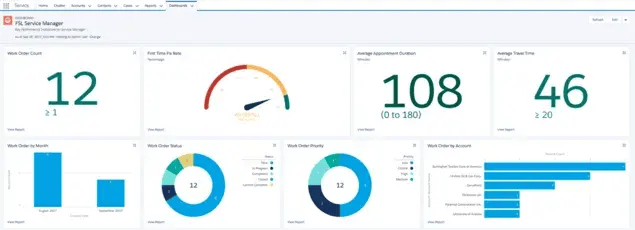
Main Benefits of Salesforce Field Service
- Smarter scheduling - AI tools match the right worker to the right job, which helps improve first-time fix rates.
- Better customer satisfaction - Accurate ETAs and status updates reduce wait times and missed appointments.
- Stronger team productivity - Mobile apps give field teams everything they need without constant back-and-forth calls.
- Works at scale - Designed for enterprise use, it can manage thousands of jobs and technicians without breaking down.
Salesforce Field Service Pros
- AI-powered scheduling and optimization. This helps dispatchers make smarter choices and reduces travel time.
- Offline-friendly mobile app. Field workers can access job details even when they don’t have a signal.
- Deep Salesforce CRM integration. Data flows smoothly between sales, service, and field teams.
- Flexible deployment with multiple license options. Companies can choose plans for contractors, dispatchers, or full-service teams.
Salesforce Field Service Cons
- Expensive compared to SMB-focused tools. Smaller companies may struggle with the higher monthly fees.
- Steep learning curve. Because it’s designed for large organizations, it requires training to maximize its potential.
- Works best if you’re already in the Salesforce ecosystem. Standalone users may find it overwhelming.
Salesforce Field Service Pricing
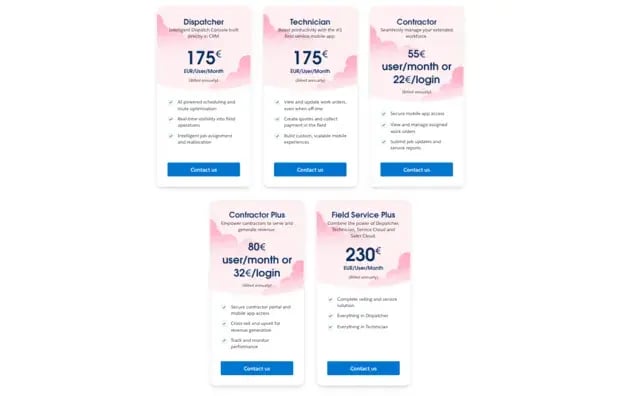
- Contractor: $50/user/month. Basic tools for individual contractors.
- Contractor Plus: $75/user/month. Adds dispatcher app and scheduling features.
- Dispatcher or Technician: $165/user/month. Full access for dispatchers or field staff.
- Field Service Plus: $220/user/month. Complete enterprise suite with advanced AI scheduling and full integration.
Best Mobile-First All-in-One Field App
Managing field teams on the go needs simple and mobile-friendly software. We compared: Connecteam, Praxedo, GoAudits, and Housecall Pro.
We evaluated ease of use, mobile experience, affordability, and the extent to which each one helps teams in the field stay connected.
How Connecteam Compares
Connecteam is a field service app designed to be an all-in-one mobile solution for small and mid-sized businesses, allowing them to get started right away.
Praxedo is flexible and powerful, but often used more in larger organizations that need complex setups.
GoAudits is great for inspections, but doesn’t cover all field service needs.
Housecall Pro is well-suited for residential contractors, but it has fewer workforce management features overall.
Connecteam wins because it strikes a balance between ease of use, strong features, and fair pricing.
|
Software
|
Best For
|
Strengths
|
Weaknesses
|
|
Connecteam
|
SMBs + growing teams
|
Mobile-first, all-in-one, affordable
|
Limited enterprise features
|
|
Praxedo
|
Larger organizations
|
Highly configurable, AI scheduling
|
More complex setup, higher cost
|
|
GoAudits
|
Inspections + checklists
|
Great for audits and compliance
|
Not full FSM solution
|
|
Housecall Pro
|
Residential contractors
|
Simple scheduling + invoicing
|
Limited beyond home services
|
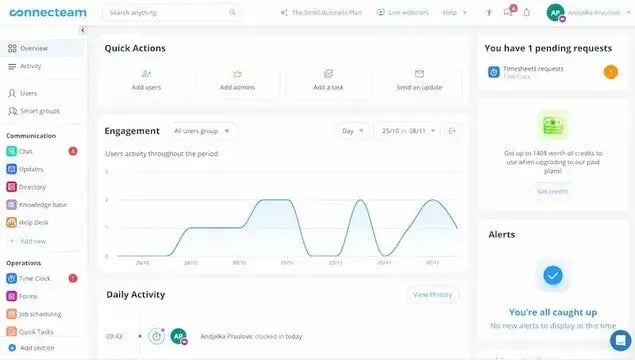
Main Benefits of Connecteam
- Better team communication - Crews can receive updates, checklists, and training directly on their phones, which reduces mistakes and confusion.
- Faster scheduling - Managers can assign shifts in minutes, and workers always know when and where they are needed.
- Cost savings - With a free plan for small teams and low-cost paid plans, businesses can save money compared to more expensive systems.
- Easy to learn - Teams can start using it quickly without long training sessions.
Connecteam Pros
- All-in-one tool for scheduling, communication, timekeeping, and training. This gives teams everything they need in one mobile app.
- Free for up to 10 users. Small businesses can start without incurring any expenses.
- Affordable scaling as teams grow. Pricing stays predictable and low compared to many other FSM tools.
- Simple and user-friendly design. Field workers pick it up quickly and don’t need extra training.
Connecteam Cons
- Less suited for very large enterprises. It doesn’t have the same depth as enterprise-grade FSM tools.
- Add-ons and scaling can increase costs over time. Larger teams may find the pricing structure more complex as they grow.
- Lacks advanced analytics. Businesses needing deep reporting may want more.
Connecteam Pricing
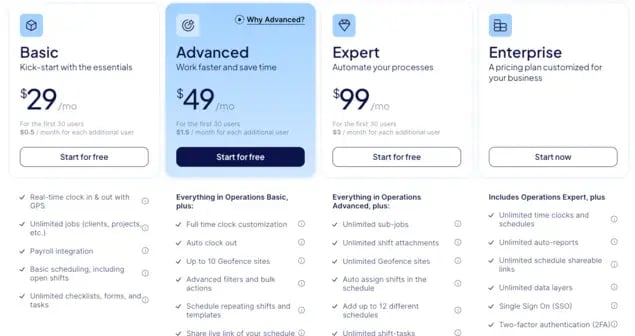
- Free plan for up to 10 users.
- Basic: $29/month plus $0.50 per user.
- Advanced: $49/month plus $1.50 per user.
- Expert: $99/month plus $3 per user.
Best Equipment & Asset Maintenance Software
Keeping equipment running is critical for field service companies. We compared UpKeep, MaintainX, Fiix, and eMaint.
We examined how they manage work orders, preventive maintenance, asset tracking, and mobile device usage.
How UpKeep Compares
UpKeep is a field service app designed to be a mobile-first CMMS that’s both simple to use and powerful enough for growing teams.
MaintainX is strong and easy to use as well, but is often seen as more expensive at scale.
Fiix has good reporting, but isn’t as intuitive on mobile. eMaint is robust but can feel complex to set up.
UpKeep wins because it strikes a balance between affordability, mobile design, and robust maintenance features.
|
Software
|
Best For
|
Strengths
|
Weaknesses
|
|
UpKeep
|
SMBs + mid-size teams
|
Mobile-first CMMS, easy to use
|
Higher tiers can get pricey
|
|
MaintainX
|
SMBs, large teams
|
Intuitive design, good mobile app
|
Can be costly at scale
|
|
Fiix
|
Mid-size businesses
|
Strong reporting + analytics
|
Less user-friendly on mobile
|
|
eMaint
|
Larger organizations
|
Robust features + customization
|
Complex setup, harder to learn
|
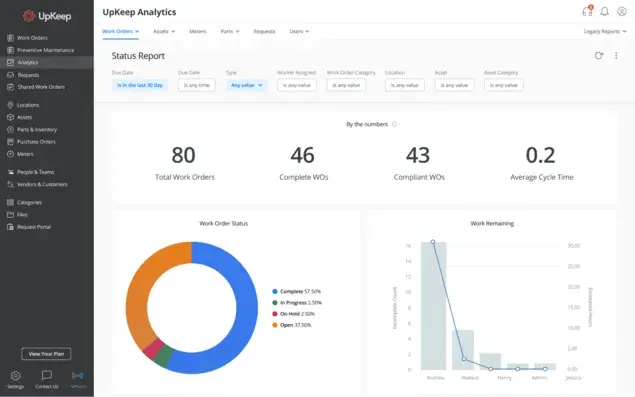
Main Benefits of UpKeep
- Reduced downtime - Preventive maintenance features help companies identify and address problems before they cause breakdowns.
- Time savings - Mobile-first design enables technicians to update work orders in the field without needing paperwork.
- Lower costs - By keeping assets in good condition, businesses save money on repairs and extend the life of their equipment.
- Easy to adopt - Simple setup and clear design make it easier for teams to start using it quickly.
UpKeep Pros
- Affordable entry-level plans. Even smaller teams can start utilizing CMMS features without incurring significant costs.
- The mobile app is highly rated. Technicians can access all the necessary information and tools in the field.
- Strong asset tracking and preventive maintenance tools. Helps companies stay on top of equipment care.
- Offline access at higher tiers. Field staff can keep working even without a signal.
UpKeep Cons
- Costs rise for Professional and Enterprise tiers. Larger organizations may find the price grows quickly.
- Reporting is good, but not as deep as some competitors. Companies needing advanced analytics may want more.
- Limited customization compared to tools like eMaint. Complex operations may need more flexibility.
UpKeep Pricing
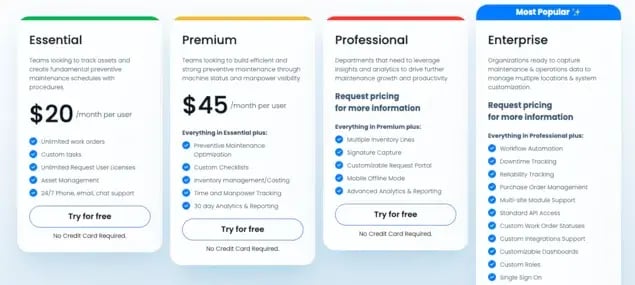
- Lite: $20/user/month. Basic work orders and asset management.
- Starter: $45/user/month. Adds preventive maintenance and dashboards.
- Professional: $75/user/month. Advanced reporting, offline access, API.
- Business+: Custom pricing for larger organizations with enterprise needs.
Best Quoting & Invoicing Software
Field service companies need an app for invoicing that’s simple, fast, and accurate.
We compared FreshBooks, Zoho Invoice, Simplybill, and Invoicera.
We evaluated ease of use, billing automation, payment processing, and the level of support provided to small businesses.
How FreshBooks Compares
FreshBooks is a field service application designed to be simple and easy for service businesses to manage invoices and payments.
Zoho Invoice is also user-friendly but has fewer advanced features.
Simplybill is very lightweight, which is fine for very small businesses but too limited for growing teams.
Invoicera offers many features but can feel harder to learn.
FreshBooks wins because it’s easy to use, mobile-friendly, and packed with invoicing tools that save time.
|
Software
|
Best For
|
Strengths
|
Weaknesses
|
|
FreshBooks
|
SMBs, freelancers
|
Simple, easy invoicing + billing
|
Add-ons increase total cost
|
|
Zoho Invoice
|
Small businesses
|
Affordable, easy to use
|
Limited advanced features
|
|
Simplybill
|
Very small teams
|
Very lightweight, cheap
|
Too basic for most needs
|
|
Invoicera
|
SMBs, enterprises
|
Feature-rich, customizable
|
Steeper learning curve
|
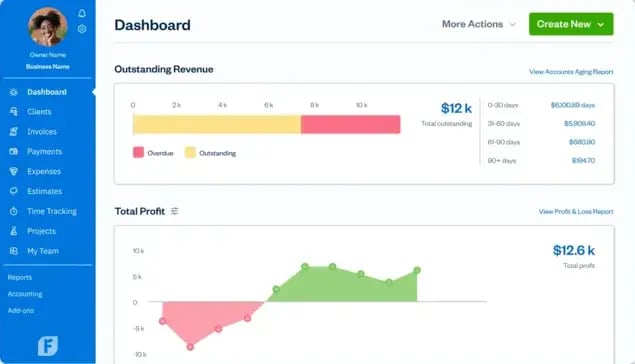
Main Benefits of FreshBooks
- Faster payments - Automated invoicing and reminders mean companies get paid quicker and with fewer delays.
- Saves time - Simple setup and recurring billing reduce admin work, letting teams focus on jobs instead of paperwork.
- Improves cash flow - Clear reporting shows who has paid and who hasn’t, making it easier to manage money coming in.
- Easy for clients - Customers can pay online with a click, which speeds up the payment process.
FreshBooks Pros
- Very easy to use, even for non-accountants. Service pros can send invoices in minutes without training.
- Strong reporting and expense tracking. Helps owners understand profits and costs in real time.
- Cloud-first with mobile apps. Invoices and payments can be managed on the go.
- Flexible plans with room to grow. Works for freelancers, small teams, and growing companies.
FreshBooks Cons
- Extra features cost more. Adding payroll, additional users, or advanced payment options increases the monthly bill.
- Limited customization compared to enterprise tools. Larger companies may find it too basic for complex billing needs.
FreshBooks Pricing
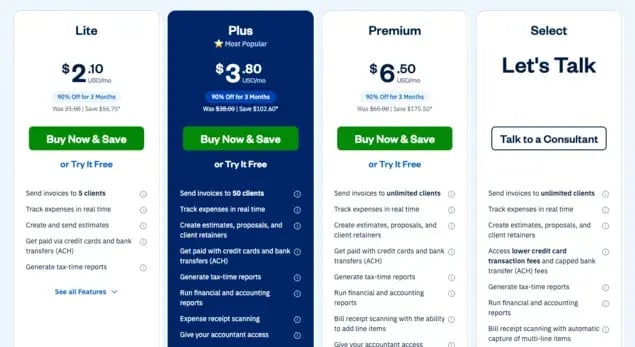
- Lite: $21/month. Good for freelancers or solo operators.
- Plus: $38/month. Best for small businesses that need recurring billing.
- Premium: $65/month. Designed for growing teams handling more clients and invoices.
- Select: Custom quote for larger companies. Tailored with dedicated support and advanced tools.
- Add-ons: $11/user/month for extra team members, $20/month for advanced payments, $40 + $6/user for payroll.
Closing Thoughts: Choose the Best Field Service App for Your Business
Field service companies run on tight margins. The right field service apps can make a big difference in profits and customer happiness. Here’s a quick guide:
- If you need route optimization to reduce costs and ensure timely deliveries, choose Elogii.
- If you need contractor management to handle jobs from quotes to invoices, go with Simpro.
- If you need workforce scheduling and dispatch at scale, go with Salesforce Field Service app.
- If you're looking for a simple mobile app for scheduling and communication, consider Connecteam.
- If you need equipment and asset maintenance to minimize downtime, choose UpKeep.
- If you need quoting and invoicing to get paid faster, go with FreshBooks.
Each tool addresses a distinct challenge, but all of them save time, reduce costs, and enhance the customer experience.
FAQ About These Field Service Apps
What is a field service management app?
It’s software that helps companies manage work done outside the office—such as dispatching crews, tracking jobs, invoicing, and maintaining equipment in good condition.
Which type of field service apps should I buy first?
It depends on your biggest challenge. If costs from driving are too high or the completion of SLAs is too low, start with route optimization software like Elogii. If payment is slow, start by issuing an invoice.
Are these field service apps only for large companies?
No. Many of them, such as Connecteam and FreshBooks, are also designed for small businesses. Larger tools, such as Salesforce Field Service, are better suited for enterprises.
Can these field service apps be integrated to work together?
Yes. Most have integrations with CRMs, accounting software, and other apps. This makes it easier to keep all your data connected.
Do I need all six apps?
Not at once. Focus on the one that solves your biggest pain point today, then add others as your business grows.












